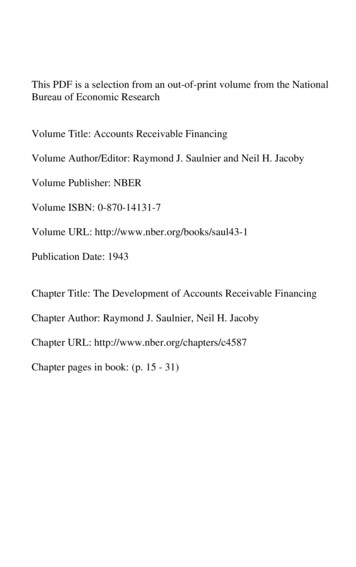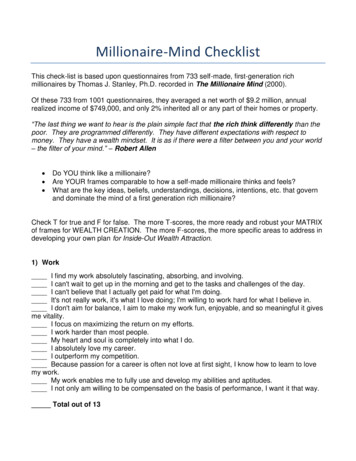
Transcription
This publication is designed to provide accurate and authoritative information inregard to the subject matter covered. It is sold with the understanding that the publisher is not engaged in rendering legal, accounting, or other professional service. Iflegal advice or other expert assistance is required, the services of a competent professional person should be sought.Vice President and Publisher: Cynthia A. ZigmundEditorial Director: Donald J. HullSenior Managing Editor: Jack KiburzInterior Design: Lucy JenkinsCover Design: Design Alliance, Inc.Typesetting: Elizabeth Pitts 2003 by William BronchickPublished by Dearborn Trade PublishingA Kaplan Professional CompanyAll rights reserved. The text of this publication, or any part thereof, may not be reproduced in any manner whatsoever without written permission from the publisher.Printed in the United States of America03 04 05 06 07 10 9 8 7 6 5 4 3 2 1Library of Congress Cataloging-in-Publication DataBronchick, William.Financing secrets of a millionaire real estate investor / WilliamBronchick.p. cm.Includes index.ISBN 0-7931-6820-1 (7.25 9 pbk.)1. Mortgage loans—United States. 2. Secondary mortgagemarket—United States. 3. Real property—United States—Finance. 4.Real estate investment—United States— Finance. I. Title.HG2040.5.U5B767 2003332.7′22— dc212003000057Dearborn Trade books are available at special quantity discounts to use for sales promotions, employee premiums, or educational purposes. Please call our Special SalesDepartment, to order or for more information, at 800-621-9621, ext. 4404, or e-mailtrade@dearborn.com.
CO N T E N T S1. Introduction to Real Estate Financing1Understanding the Time Value of Money 2The Concept of Leverage 2Owning Property “Free and Clear” 5How Financing Affects the Real Estate Market 6How Financing Affects Particular Transactions 7How Real Estate Investors Use Financing 8When Is Cash Better Than Financing? 9What to Expect from This Book 10Key Points 102. A Legal Primer on Real Estate Loans11What Is a Mortgage? 11Promissory Note in Detail 12The Mortgage in Detail 14The Deed of Trust 15The Public Recording System 15Priority of Liens 16What Is Foreclosure? 17Judicial Foreclosure 17Nonjudicial Foreclosure 18Strict Foreclosure 19Key Points 193. Understanding the Mortgage Loan Market21Institutional Lenders 21Primary versus Secondary Mortgage Markets 22Mortgage Bankers versus Mortgage Brokers 23Conventional versus Nonconventional Loans 25Conforming Loans 25Nonconforming Loans 28v
viCONTENTSGovernment Loan Programs 28Federal Housing Administration Loans 29The Department of Veterans Affairs 30State and Local Loan Programs 31Commercial Lenders 31Key Points 324. Working with Lenders33Interest Rate 33Loan Amortization 3415-Year Amortization versus 30-Year Amortization 36Balloon Mortgage 37Reverse Amortization 38Property Taxes and Insurance Escrows 38Loan Costs 39Origination Fee 39Discount Points 39Yield Spread Premiums: The Little Secret Your LenderDoesn’t Want You to Know 39Loan Junk Fees 40“Standard” Loan Costs 41Risk 44Nothing Down 45Loan Types 46Choosing a Lender 48Length of Time in Business 49Company Size 50Experience in Investment Properties 50How to Present the Deal to a Lender 51Your Credit Score 52Your Provable Income 56The Property 56Loan-to-Value 58The Down Payment 59Income Potential and Resale Value of the Property 60Financing Junker Properties 60Refinancing—Worth It? 61Filling Out a Loan Application 61Key Points 62
viiCONTENTS5. Creative Financing through Institutional LendersDouble Closing—Short-Term Financing without Cash 63Seasoning of Title 65The Middleman Technique 67Case Study #1: Tag Team Investing 69Case Study #2: Tag Team Investing 70Using Two Mortgages 71No Documentation and Nonincome Verification Loans 72Develop a Loan Package 75Subordination and Substitution of Collateral 76Case Study: Subordination and Substitution 77Using Additional Collateral 79Blanket Mortgage 79Using Bonds as Additional Collateral 80Key Points 826. Hard Money and Private Money83Emergency Money 83Where to Find Hard-Money Lenders 84Borrowing from Friends and Relatives 85Using Lines of Credit 86Credit Cards 86Key Points 877. Partnerships and Equity Sharing89Basic Equity-Sharing Arrangement 90Scenario #1: Buyer with Credit and No Cash 90Scenario #2: Buyer with Cash and No Credit 91Your Credit Is Worth More Than Cash 91Tax Code Compliance 92Pitfalls 93Alternatives to Equity Sharing 93Joint Ventures 94Using Joint Venture Partnerships for Financing 94Legal Issues 95Alternative Arrangement for Partnership 95Case Study: Shared Equity Mortgage with Seller 96When Does a Partnership Not Make Sense? 97Key Points 9863
viiiCONTENTS8. The Lease Option99Financing Alternative 100Lease—The Right to Possession 100Sublease 100Assignment 100More on Options, the “Right” to Buy 101An Option Can Be Sold or Exercised 102Alternative to Selling Your Option 102The Lease Option 103The Lease Purchase 103Lease Option of Your Personal Residence 104The Sandwich Lease Option 106Cash Flow 107Equity Buildup 107Straight Option without the Lease 108Case Study: Sandwich Lease Option 109Sale-Leaseback 110Case Study: Sale-Leaseback 111Key Points 1129. Owner Financing113Advantages of Owner Financing 115Easy Qualification 115Cheaper Costs 116Faster Closing 116Less Risk 116Future Discounting 117Assuming the Existing Loan 117Assumable Mortgages 117Assumable with Qualification 118Buying Subject to the Existing Loan 118Risk versus Reward 119Convincing the Seller 120A Workaround for Down-Payment RequirementsInstallment Land Contract 122Benefits of the Land Contract 124Problems with the Land Contract 125Using a Purcahse Money Note 125Variation: Create Two Notes, Sell One 126Another Variation: Sell the Income Stream 126121
ixCONTENTSWraparound Financing 127The Basics of Wraparound Financing 127Wraparound versus Second Mortgage 130Mirror Wraparound 132Wraparound Mortgage versus Land ContractKey Points 13310. Epilogue133135Appendix A Interest Payments Chart 139Appendix B State-by-State Foreclosure Guide 141Appendix C Sample Forms 143Uniform Residential Loan Application[FNMA Form 1003] 144Good Faith Estimate of Settlement Costs 148Settlement Statement [HUD-1] 149Note [Promissory—FNMA] 151California Deed of Trust (Short Form) 153Mortgage [Florida—FNMA] 155Option to Purchase Real Estate [Buyer-Slanted] 171Wrap Around Mortgage [or Deed of Trust] Rider 173Installment Land Contract 174Subordination Agreement 176Glossary 179Resources 187Suggested Reading 187Suggested Web Sites 188Real Estate Financing Discussion Forums 188Index 189
C H A P T E R1Introduction to RealEstate FinancingKnowledge is power.—Francis BaconIn 1991, I made my first attempt at financing an investment property through creative means. With a lot of guts and a little knowledge,I made an offer that was accepted by the seller. I tendered 1,000 asearnest money on the sales contract, then proceeded to try to makethe deal work. I failed, lost my 1,000, but I learned an important lesson—a little knowledge can be dangerous. I decided then to become amaster at real estate finance.Financing has traditionally been, and will always be, an integralpart of the purchase and sale of real estate. Few people have the fundsto purchase properties for all cash, and those that do rarely sink all oftheir money in one place. Even institutional and corporate buyers ofreal estate use borrowed money to buy real estate.This book explains how to utilize real estate financing in themost effective and profitable way possible. Mostly, this book focuseson acquisition techniques for investors, but these techniques are alsoapplicable to potential homeowners.1
2FINA NCING SECRETS OF A MILLIONAIRE REAL ESTATE IN VESTORUnderstanding the Time Value of MoneyIn order to understand real estate financing, it is important thatyou understand the time value of money. Because of inf lation, a dollartoday is generally worth less in the future. Thus, while real estate values may increase, an all-cash purchase may not be economically feasible, because the investor’s cash may be utilized in more effective ways.The cost of borrowing money is expressed in interest payments,usually a percent of the loan amount. Interest payments can be calculated in a variety of ways, the most common of which is simple interest. Simple interest is calculated by multiplying the loan amount by theinterest rate, then dividing it up into period (12 months, 15 years, etc). Example: A 100,000 loan at 12% simple interest is 12,000per year, or 1,000 per month. To calculate monthly simpleinterest payments, take the loan amount (principal), multiplyit by the interest rate, and then divide by 12. In this example, 100,000 .12 12,000 per year 12 1,000 per month.Mortgage loans are generally not paid in simple interest butrather by amortization schedules (discussed in Chapter 4), calculatedby amortization tables (see Appendix A). Amortization, derived fromthe Latin word “amorta” (death), is to pay down or “kill” a debt. Amortized payments remain the same throughout the life of the loan but arebroken down into interest and principal. The payments made near thebeginning of the loan are mostly interest, while the payments near theend are mostly principal. Lenders increase their return and reducetheir risk by having most of the profit (interest) built into the front ofthe loan.The Concept of LeverageLeverage is the process of using borrowed money to make a return on an investment. Let’s say you bought a house using all of yourcash for 100,000. If the property were to increase in value 10 percent
1 / Introduction to Real Estate FinancingThe Federal Reser ve and Interest RatesThe Federal Reserve (the Fed) is an independententity created by an Act of Congress in 1913 toser ve as the central bank of the United States.There are 12 regional banks that make up the Federal Reserve System. While the regional banks arecorporations whose stock is owned by memberbanks, the shareholders have no inf luence over theFederal Reserve banks’ policies.Among other things, the function of the Fed isto try to regulate inf lation and credit conditions inthe U.S. economy. The Federal Reserve banks alsosupervise and regulate depository institutions.So how does the Fed’s policy affect interestrates on loans? To put it simply, by manipulating“supply and demand.” The Fed changes the moneysupply by increasing or decreasing reserves in thebanking system through the buying and selling ofsecurities. The changes in the money supply, inturn, affect interest rates: the lower the supply ofmoney, the higher the interest rate that is chargedfor loans between banks. The more it costs a bankto borrow money, the more they charge in interestto consumers to borrow that money. The preceding is a simplified explanation, because there areother factors in the world economy that affectinterest rates and money supply. And, of course,there are also widely varying opinions by economists as to what factors drive the economy andinterest rates.3
4FINA NCING SECRETS OF A MILLIONAIRE REAL ESTATE IN VESTORover 12 months, it would now be worth 110,000. Your return on investment would be 10 percent annually (of course, you would actuallynet less because you would incur costs in selling the property).Equity Property value – Mortgage debtIf you purchased a property using 10,000 of your own cash and 90,000 in borrowed money, a 10 percent increase in value wouldstill result in 10,000 of increased equity, but your return on cash is100 percent ( 10,000 investment yielding 20,000 in equity). Ofcourse, the borrowed money isn’t free; you would have to incur loancosts and interest payments in borrowing money. However, by renting the property in the meantime, you would offset the interestexpense of the loan.Calculating Return on InvestmentAnnual return on investment (ROI) is the interestrate you yield on your cash investment. It is calculated by taking the annual cash f low or equityincrease and dividing it by the amount of cashinvested.Let’s also look at the income versus expense ratios. If you purchased a property all cash for 100,000 and collected 1,000 permonth in rent, your annual cash-on-cash return is 12 percent (simplydivide the annual income, 12,000, by the amount of cash invested, 100,000).If you borrowed 90,000 and the payments on the loan were 660 per month, your annual net income is 4,080 ( 12,000 – [ 660 12 ]), but your annual cash-on-cash return is about 40 percent(annual cash of 4,080 divided by 10,000 invested).
1 / Introduction to Real Estate Financing5FIGURE 1.1 Owning Free and Clear versus Mortgaging100%Free andClear10% DownPayment90%FinancingFREE AND CLEAR PROPERTYValue 100,000Cash Investment 100,000Annual Net Income 12,000Return on Investment 12%90% FINANCED PROPERTYValue 100,000Cash Investment 10,000Annual Net Income 4,080Return on Investment 40.8%So, if you purchased ten properties with 10 percent down and90 percent financing, you could increase your overall profit by morethan threefold. Of course, you would also increase your risk, whichwill be discussed in more detail in Chapter 4.Owning Property “Free and Clear”For some investors, the goal is to own properties “free and clear,”that is, with no mortgage debt. While this is a worthy goal, it does notnecessarily make financial sense. See Figure 1.1.
6FINA NCING SECRETS OF A MILLIONAIRE REAL ESTATE IN VESTOR Example: Consider a 100,000 property that brings in 10,000 per year in net income (net means gross rents collected, less expenses, such as property taxes, maintenance,utilities, and hazard insurance). The 100,000 in equity thusyields a 10 percent annual return on investment ( 10,000,the annual net cash f low, divided by 100,000, the equityinvestment).If the property were financed for 80 percent of its value ( 80,000)at 7.5 percent interest, the monthly payment would be approximately 560 per month, or 6,720 per year. Net rent of 10,000 per yearminus 6,720 in debt payments equals 3,280 per year in net cashf low. Divide the 3,280 in annual cash f low by the 20,000 in equityand you have a 16.4 percent return on investment. Furthermore, with 80,000 more cash, you could buy four more properties. As you cansee, financing, even when you don’t necessarily “need” to do so, canbe more profitable than investing all of your cash in one property.How Financing Affects the Real Estate MarketBecause financing plays a large part in real estate sales, it also affects values; the higher the interest rate, the larger your monthly payment. Conversely, the lower the interest rate, the lower the monthlypayment. Thus, the lower the interest rate, the larger the mortgageloan you can afford to pay. Consequently, the larger the mortgage youcan afford, the more the seller can ask for in the sales prices.A lso, people with less cash are usually more concerned withtheir payment than the total amount of the purchase price or loanamount. On the other hand, people with all cash are more concernedwith price. Because most buyers borrow most of the purchase price,the prices of houses are affected by financing. Thus, when interestrates are low, housing prices tend to increase, because people canafford a higher monthly payment. Conversely, when interest rates arehigher, people cannot afford as much a payment, generally drivingreal estate prices down.
1 / Introduction to Real Estate Financing7Since the mid-1990s, the prices of real estate have dramaticallyincreased in most parts of the country. The American economy hasgrown, the job growth during this period has been good, but mostimportant, interest rates have been low.How Financing Affects Particular TransactionsWhen valuing residential properties, real estate appraisers generally follow a series of standards set forth by professional associations(the most well-known is the Appraisal Institute). Sales of comparableproperties are the general benchmark for value. Appraisers look notjust at housing sale prices of comparable houses, but also at thefinancing associated with the sales of these houses. If the house wasowner-financed (discussed in Chapter 9), the interest rate is generallyhigher than conventional rates and/or the price is inf lated. The priceis generally inf lated because the seller’s credit qualifications arelooser than that of a bank, which means the buyer will not generallycomplain about the price.Take a Cue from Other IndustriesThe explosion of the electronics market, the automobile market, and other large-ticket purchasemarkets is directly affected by financing. Justthumb through the Sunday newspapers and youwill see headlines such as “no money down” or“no payments for one year.” These retailers havelearned that financing moves a product because itmakes it easier for people to justify the purchase.Likewise, the price of a house may be stretched abit more when it translates to just a few dollarsmore per month in mortgage payments.
8FINA NCING SECRETS OF A MILLIONAIRE REAL ESTATE IN VESTORAppraisals on income properties are done in a variety of ways,one of which is the “income” approach. The income approach looksat the value of the property versus the rents the property can produce. While financing does not technically come into the equation, itdoes affect the property’s profitability to the investor. Thus, a property that can be financed at a lower interest rate will be more attractive to the investor if cash f low is a major concern.Tax Impact of FinancingDown payments made on a property as an investorare not tax-deductible. In fact, a large down payment offers no tax advantage at all because the investor’s tax basis is based on the purchase price,not the amount he or she puts down. However, because mortgage interest is a deductible expense,the investor does better tax wise by saving his orher cash. Think about it: the higher the monthlymortgage payment, the less cash f low, the less taxable income each year. While positive cash f low isdesirable, it does not necessarily mean that a property is more profitable because it has more cashf low. A larger down payment will obviously increase monthly cash f low, but it is not always thebest use of your money.How Real Estate Investors Use FinancingAs discussed above, investors use mortgage loans to increasetheir leverage. The more money an investor can borrow, the more heor she can leverage the investment. Rarely do investors use all cash topurchase properties, and when they do, it is on a short-term basis.They usually refinance the property to get their cash back or sell theproperty for cash.
1 / Introduction to Real Estate Financing9The challenge is that loans for investors are treated as high-riskby lenders when compared to noninvestor (owner-occupied properties) loans. Lenders often look at leveraged investments as risky andare less willing to loan money to investors. Lenders assume (often correctly) that the less of your own money you have invested, the morelikely you will be to walk away from a bad property. In addition, fewerinvestor loan programs mean less competition in the industry, whichleads to higher loan costs for the investor. The goal of the investor thusis to put forth as little cash as possible, pay the least amount in loancosts and interest, while keeping personal risk at a minimum. This isquite a challenge, and this book will reveal some of the secrets foraccomplishing this task.When Is Cash Better Than Financing?Using all cash to purchase a property may be better than financing in two particular situations. The first situation is a short-term deal,that is, you intend to sell the house shortly after you buy it (known as“f lipping”). When you have the cash to close quickly, you can generally get a tremendous discount on the price of a house. In this case,financing may delay the transaction long enough to lose an opportunity. Cash also allows you to purchase properties at a larger discount.You’ve heard the expression, “money talks, BS walks.” This is particularly true when making an offer to purchase a property through a realestate agent. The real estate agent is more likely to recommend to hisor her client a purchase offer that is not contingent on the buyerobtaining bank financing.The second case is one in which you can use your retirement account. You can use the cash in your IR A or SEP to purchase real estate,and the income from the property is tax-deferred. In order to do this,you need an aggressive self-directed IR A custodian (oddly enough,most IR A custodians view real estate as “risky” and the stock market as“safe”) . Two such custodians are Mid Ohio Securities, w w w.midoh.com , or Entrust Administration, www.entrustadmin.com .
10FINA NCING SECRETS OF A MILLIONAIRE REAL ESTATE IN VESTORUnderstanding a Cash Offerversus Paying All CashIf you make a “cash offer” on a property, it does notnecessarily mean you are using all of your owncash. It means the seller is receiving all cash, as opposed to the seller financing some part of the purchase price (discussed more fully in Chapter 9).What to Expect from This BookThis book will show you how to finance properties with as littlecash as possible, while maintaining minimum risk and maximumprofit.The first few chapters describe the mortgage loan process, legaldetails, and the banking industry. Chapter 4 covers different types oflenders and loans, and the benefits of each. Chapter 5 covers how tocreatively use institutional loan programs as an investor. Chapters 6,7, 8, and 9 cover creative, noninstitutional financing.As with any technique on real estate acquisition or finance, youshould review the process with a local professional, including an attorney. Also, keep in mind that while most of these ideas are applicablenationwide, local practices, laws, rules, customs, and market conditions may require variations or adaptations for your particular use.Key Points Interest rates affect property values. Financing affects the value of a property to an investor. Investors use financing to leverage their investments.
C H A P T E R2A Legal Primer onReal Estate LoansIf there were no bad people there would be no good lawyers.— Charles DickensBefore we discuss lenders, loans, and loan terms, it is essentialthat you understand the legal fundamentals and paperwork involvedwith mortgage loans. By analogy, you cannot make a living buying andselling automobiles without a working knowledge of engines and cartitles. Likewise, you need to understand how the paperwork fits intothe real estate transaction. Without a working knowledge of thepaperwork, you are at the mercy of those who have the knowledge.Furthermore, without the know-how your risk of a large mistake ormissed opportunity increases tremendously.What Is a Mortgage?Most of us think of going to a bank to get a mortgage. Actually,you go to the bank to get a loan. Once you are approved for the loan,you sign a promissory note to the lender, which is a legal promise to11
12FINA NCING SECRETS OF A MILLIONAIRE REAL ESTATE IN VESTORFIGURE 2.1 The Mortgage TransitionPromissory Note:Legal Obligation to PayBorrowerSecurity Instrument(Mortgage or Deed of Trust)Collateral for NoteLenderpay. You also give the lender (not get) a mortgage as security for repayment of the note. A mortgage (also called a “deed of trust” in somestates) is a security agreement under which the borrower pledges hisor her property as collateral for payment. The mortgage document isrecorded in the county property records, creating a lien on the property in favor of the lender. See Figure 2.1.If the underlying obligation (the promissory note) is paid off, thelender must release the collateral (the mortgage). The release willremove the mortgage lien from the property. If you search the publicrecords of a particular property, you will see many recorded mortgages that have been placed and released over the years.Promissory Note in DetailA note is an IOU or promise to pay; it is a legal obligation. Apromissory note (also known as a “note” or “mortgage note”) spellsout the amount of the loan, the interest to be paid, how and when payments are made, and what happens if the borrower defaults. The note
2 / A Legal Primer on Real Estate Loans13may also contain disclosures and other provisions required by federalor state law.A Mortgage Note Is a Negotiable InstrumentLike a check, a mortgage note can be assigned andcollected by whoever holds the note. As discussedin Chapter 3, mortgage notes are often bought,sold, traded, and hypothecated (pledged as collateral).Most lenders use a form of note that is approved by the FederalNational Mortgage Association (FNM A, or Fannie Mae). A sampleform of this note can be found in Appendix C. The note is signed (inlegal terms, “executed”) by the borrower. The original note is held bythe lender until the debt is paid in full, at which time the original noteis returned to the borrower marked “paid in full.”A Promissory Note Is a Personal ObligationBecause promissor y notes are personal obligations, the history of payments will appear on yourcredit file, even if the debt is used for investment.If you fail to pay on the note, your credit will beadversely affected, and you risk a lawsuit from thelender. Some notes are nonrecourse, that is, thelender cannot sue you personally. A lthough notalways possible, you should try to make sure mostof your debt is nonrecourse.
14FINA NCING SECRETS OF A MILLIONAIRE REAL ESTATE IN VESTORFIGURE 2.2 Parties to a MortgageBorrower/MortgagorLender/MortgageeThe Mortgage in DetailThe security agreement executed by the borrower pledges theproperty as collateral for the note. Known by most as a “mortgage,”this document, when recorded (discussed below), creates a lien infavor of the lender. The mortgage agreement is generally a standardized form approved by FNMA. While the form of note is generally thesame from state to state, the mortgage form differs slightly becausethe legal process of foreclosure (the lender’s right to proceed againstthe collateral) is different in each state. See Figure 2.2.The mortgage document will state that upon default of the note,the lender can exercise its right to foreclose on the property. Foreclosure is the process of lenders exercising their legal right to proceedagainst the collateral for the loan (discussed later in this chapter). Italso places other obligations upon the borrower, such as maintaining the property, paying property taxes, and keeping the property insured.
152 / A Legal Primer on Real Estate LoansFIGURE 2.3 Parties to a Deed of TrustBorrower/TrustorLender/BeneficiaryTrusteeThe Deed of TrustSome states (e.g., California) use a document called a “deed oftrust” (AKA “trust deed”) rather than a mortgage. The deed of trust isa document in which the trustor (borrower) gives a deed to the neutralthird party (trustee) to hold for the beneficiary (lender). A deed oftrust is worded almost exactly the same as a mortgage, except for thenames of the parties. Thus, the deed of trust and mortgage are essentially the same, other than the foreclosure process. See Figure 2.3.The Public Recording SystemThe recording system gives constructive notice to the public ofthe transfer of an interest in property. Recording simply involvesbringing the original document to the local county courthouse orcounty clerk’s office. The original document is copied onto a computer file or onto microfiche and is returned to the new owner. Thereis a filing fee of about 6 to 10 per page for recording the document.
16FINA NCING SECRETS OF A MILLIONAIRE REAL ESTATE IN VESTORIn addition, the county, city, and/or state may assess a transfer taxbased on either the value of the property or the mortgage amount.A deed or other conveyance does not have to be recorded to bea valid transfer of an interest. For example, what happens if John givestitle to Mary, then he gives it again to Fred, and Fred records first?What happens if John gives a mortgage to ABC Savings and Loan, butthe mortgage is not filed for six months, and then John immediatelyborrows from another lender who records its mortgage first? Whowins and loses in these scenarios?Most states follow a “race-notice” rule, meaning that the first person to record his document, wins, so long as he received title in good faith, he paid value, and he had no notice of a prior transfer. Example: John buys a home and, in so doing, borrows 75,000 from A BC Savings Bank. John signs a promissorynote and a mortgage pledging his home as collateral. BecauseABC messes up the paperwork, the mortgage does not get recorded for 18 months. In the interim, John borrows 12,000from The Money Store, for which he gives a mortgage as collateral. The Money Store records its mortgage, unaware ofJohn’s unrecorded first mortgage to ABC. The Money Storewill now have a first mortgage on the property.Priority of LiensLiens, like deeds, are “first in time, first in line.” Thus, if a property is owned free and clear, a mortgage recorded will be a first mortgage. A mortgage recorded thereafter will be a second mortgage(sometimes called a junior mortgage because its lien position is behind the first mortgage). Likewise, any judgments or other liens recorded later are also junior liens. Holding a first mortgage is a desirable
2 / A Legal Primer on Real Estate Loans17position because a foreclosure on a mortgage can wipe out all liensthat are recorded behind it (called “junior lien holders”). The processof foreclosure will be discussed in more detail later in this chapter.At the closing of a typical real estate sale, the seller conveys adeed to the buyer. Most buyers obtain a loan from a conventionallender for most of the cash needed for the purchase price. As discussed earlier, the lender gives the buyer cash to pay the seller, andthe buyer gives the lender a promissory note. The buyer also gives thelender a security instrument (mor
real estate use borrowed money to buy real estate. This book explains how to utilize real estate financing in the most effective and profitable way possible. Mostly, this book focuses on acquisition techniques for investors, but these techniques are also applicable to










